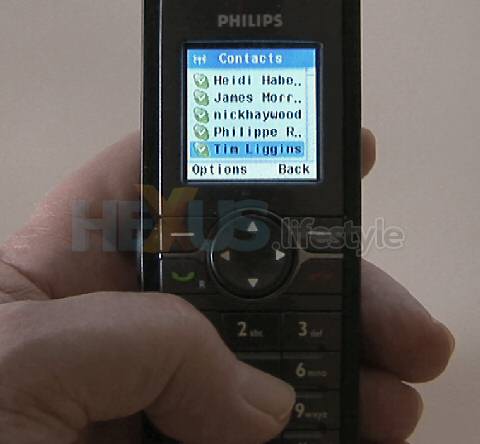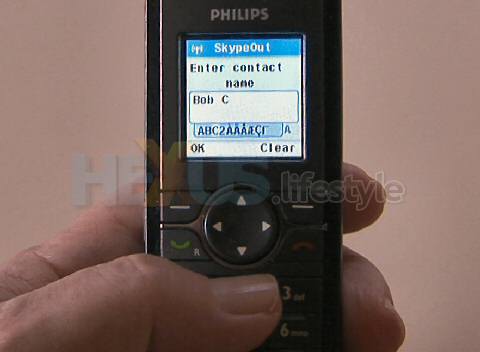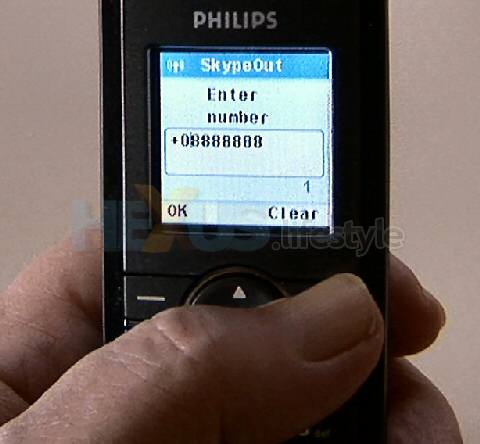Setting up & going hands-on
Basic setting up involves nothing more than connecting the base-station to the phone line and your network router, then putting power to the base-station and the charger. A router is a must, though. You can't use the Skype features if you connect to the net with an ADSL USB modem.
Presuming that your internet connection is live and your router set up to use DHCP to dish out IP addresses, then the phone will automatically join your network and be ready to connect to the net.
If you need or want to manually set up the IP addresses of your PCs and other networked devices, then there's an option (Settings> Network> Static IP) to do this on the phone, too.
Before you can make or take VOIP calls, though, you need to tell the phone what Skype account to use.
If you already have an account, it's just a matter of inputting your Skype user name and password on the phone's keypad (and "just" really is the right word to use here, as we'll explain).
Once the phone connects to Skype, it downloads all of the contact details you'd already set up for that account on a PC (these are stored on Skype's own servers) - so you're ready to start phoning straight away.
Click for larger image
And it downloads all your contacts - not just those for other Skype users but also the landline and mobile details of people you call using SkypeOut.
A nice touch is that when you highlight a contact, the name starts scrolling left to right, so you can properly read longer names, most importantly, those you've annotated by, for instance, reference to whether this is a person's landline or mobile number.
Also neat is that the phone's home-page display shows you how much Skype credit you have remaining - so there's little chance of your running out without knowing.
If you need or want to set up an all-new Skype account, then what you do is decide on the name you'll use and key that into the phone, though this name will be rejected if someone has it already. You then choose a password and input, that, too.
The downside of starting off with a brand new account is that you'll have no names and details coming into the phone from an existing Skype contacts list.
But that's not a tragedy. The way things have been implemented, if you also set up that account on a PC, you can input contact details there and they'll get synched up onto the phone.
And this is a two-way thing, so if you key in contact details on the phone for any reason, these will appear on your PC, too.
We were initially thinking that this ability for the phone to use the Skype contacts-list that you see on a PC was something we'd be especially appreciate because it would save the hassle of keying them in all over again on the phone's non-Qwerty keypad - and that is indeed an important consideration.
Yet, the fact is that we were bowled over by how easy it is to use the phone's keypad for inputting alpha-numeric characters, and know there would be situations where we'd be happy to use the phone to add a new contact's details - especially if the PC were turned off and we couldn't be bothered to turn it back on.
We're willing to accept that there may be other phones - mobile, DECT, Skype WiFi, whatever - that allow you to enter contact details as easily as the Philips, it's just that no phone as natural to use has yet come our way.
Two things make life with the Philips especially easy.
First there's a shift button (the star key) that cycles through what effect each alpha-numeric key will produce - lower-case (small letters), upper case (large, capital letters) or numbers.
Unlike some phones, the shift doesn't turn off after the first character you input - and we regard that as a good thing, not bad or, at any rate, more intuitive, especially for folk who don't use phones a lot.
And, in contrast with some other phones, having a shift key means that you don't have to cycle through all the possible character combinations - including upper and lower case - something that we've found to be rather disorientating.
Too often, first time round, we've ended up missing the letter we wanted - and sometimes the second and third times, too.
Consequently on some of the phones we use, the names in our contacts lists lack capitals where they're needed and have them in places where they're not wanted.
But what really makes the difference more profound with the VOIP841 is a small sub-display that appears on the phone's screen once you start inputting characters.
This sub-display shows you all of the characters that are available from the key you've just pressed in the phone's current shift mode and, better still, puts a highlight over the active character, so you know just where you are.
Let's say you want to add a contact to the address book whose name is Bob (and who wouldn't want to do that?). Well, you'd start off by pressing the star key (to be in upper-case/capitals mode), then press the 2abc button twice - to move past A and reach B.
But, the great thing is that as you make any key selection, the little sub-display pops up and shows you what characters you will be choosing as you repeatedly press the same button. And, until you've tried it (or, at least, seen it in action), you probably won't appreciate how useful this is and how big a difference it makes.
In the case of the 2abc button in shift mode, what you see listed (in order) are, A, B and 2, followed by five non-English characters - ÀÅÆÇΓ.
So (and remember we're trying to make an entry for a geezer called Bob) having pressed the 2abc twice to select B - and paused a moment for that to register - you'd press the star key twice to get back to lower-case/small-letters mode and then press the 6mno button three times to input an o, followed by the 2abc key twice to select the final b.
And, all the while you're pressing keys, you're able to see in that little sub-display what characters are available from that key.
Sweet!
Mind you, what we thought would make things even sweeter is if the phone's left/right arrow keys let you move through the list of available characters in the sub-display - but they don't.
Pressing the left or right arrow key does something different. It accepts the currently active character immediately - rather than you having to wait a second or so for the active character to register automatically. It also lets you navigate in the main display through the characters that have been registered.
This makes editing easy and that process is made even easier by the phone's other two direction-arrow buttons - up and down. These let you jump to the start or end of the name or phone number you're inputting or of a contact that's already there.
Arrow keys that let you scroll through the characters in the sub-display would make the selection of characters easier still but there's only so much available space on a handset to fit it extra buttons. Nonetheless, food for thought, Philips, for the MkII?
Irrespective of that, a lot of time and intelligence has been applied here and it show. We've never found inputting characters on a phone (or a remote handset) as easy as this before and so it's probably a little unfair of us to harp on.
Such attention to detail has been applied everywhere else we've looked and is the reason why, as you'll see on page four, that our final take on the VOIP is so very positive.













